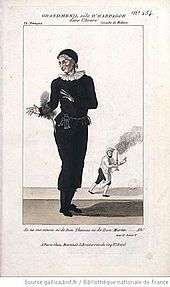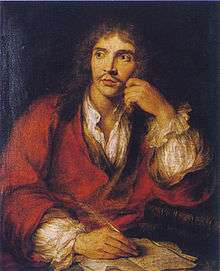The Miser
| The miser | |
|---|---|
 | |
| Written by | Molière |
| Characters |
|
| Date premiered | September 9, 1668 |
| Place premiered | Paris |
| Original language | French |
| Subject | Avarice |
| Genre | Comedy |
| Setting | Paris, in Harpagon's house |
The Miser (French: L'Avare; pronounced: [lavaʁ]) is a five-act comedy in prose by the French playwright Molière. It was first performed on September 9, 1668, in the theatre of the Palais-Royal in Paris.[1]
The play
The play was first produced when Molière's company was under the protection of Louis XIV himself. It was loosely based on the Latin comedy Aulularia by Plautus, from which many incidents and scraps of dialogue are borrowed, as well as from contemporary Italian farces.[2][3]
The miser of the title is called Harpagon, a name adapted from the Latin harpago, meaning a hook or grappling iron. He is obsessed with the wealth he has amassed and always ready to save expenses. Now a widower, he has a son, Cléante, and a daughter, Élise. Although he is over sixty, he is attempting to arrange a marriage between himself and an attractive young woman, Mariane. She and Cléante are already devoted to each other, however, and the son attempts to procure a loan to help her and her sick mother, who are impoverished. Élise, Harpagon's daughter, is the beloved of Valère, but her father hopes to marry her to a wealthy man of his choosing, Seigneur Anselme. Meanwhile, Valère has taken a job as steward in Harpagon's household so as to be close to Élise. The complications are only resolved at the end by the rather conventional discovery that some of the principal characters are long lost relatives.
Satire and farce blend in the fast-moving plot, as when the miser's hoard is stolen. Asked by the police magistrate whom he suspects, Harpagon replies, “Everybody! I wish you to take into custody the whole town and suburbs” (5.1) and indicates the theatre audience while doing so. The play also makes fun of certain theatrical conventions, such as the spoken aside addressed to the audience, hitherto ignored by the characters onstage. The characters of L'Avare, however, generally demand to know who exactly is being spoken to.[4]
Roles

- Harpagon
- The tyrannical father of Cléante and Élise Harpagon is a sexagenarian bourgeois miser whose love for his cash box exceeds that of his children. He builds his wealth by lending at usurious rate while pinching every penny at home, refusing to replace the worn-out clothes of the servants he abuses. The sexagenarian is suitor of the young Mariane, whom Cléante also wishes to marry.[5]
- Cléante
- Harpagon's profligate son, Cléante is also in love with Mariane. Intending to run away with her, he attempts to procure an illegal loan to provide Mariane and her ill mother with money, only to discover the lender is his own father. There is mutual resentment between the two over not only money but over love when Harpagon tricks his son into revealing his love for Mariane.[6]
- Élise
- The daughter of Harpagon, Élise owes her life to Valère, who saved her from drowning just before the beginning of the play. She opposes her father's plans to wed her to the elderly Anselme, who has agreed to take her without a dowry.[7]
- Valère
- Valère has saved Élise from drowning and has come into the employ of Harpagon with intentions to win her. Harpagon mistrusts him and suspects him of wanting to rob him. At the end it is revealed he is of noble Napolitan blood, the brother of Mariane, and the son of Anselme who is really Don Thomas D'Alburcy.
- La Flèche
- A servant in Harpagon's household, La Flèche helps Cléante arrange a clandestine loan through Master Simon.[6] In a dramatic turn he digs up and steals Harpagon's cash box.[8]

- Master Jacques
- Master Jacques is cook and coachman to Harpagon.[9]
- Anselme
- An elderly gentleman and suitor to Élise, Anselme is a wandering Napolitan noble who believes his wife and children drowned sixteen years earlier. At the climax it is discovered that Valère and Mariane are his children and his real name is Don Thomas D'Alburcy.[10]
- Mariane
- The young woman whom Harpagon intends to wed is also the woman his son Cléante intends to run away with. She is revealed at the end to be the sister of Valère and daughter of Anselme, who is really Don Thomas D'Alburcy of Naples.
- Master Simon
- A dishonest character, Master Simon tries to arrange a usurious loan between Cléante and his father.[6]
- Frosine
- Frosine is an elderly woman who acts as a go-between to ensure the marriage of Harpagon and Mariane; she convinces Harpagon that Mariane's frugality will outweigh her lack of dowry, and that Mariane loves bespectacled old men.[11]
Harpagon's servants with minor roles include Brindavoine,[12] La Merluche,[12] and Mistress Claude, a cleaning woman with no lines.[13] In the last act appears a Magistrate[lower-alpha 1] who investigates the theft of the cash-box[14] with his Clerk, who has no spoken part.[15]
Sources
Aside from the example of contemporary misers,[16] Molière drew from a number of ancient and contemporary sources for elements in his The Miser. The character of Harpagon draws from the Latin play Aulularia by Plautus in which the miser Euclio incessantly changes the hiding place of his pot of gold out of fear of having it stolen, and the miser's fourth-act[lower-alpha 2] monologue exaggerating the loss of his pot was the basis for Harpagon's. Also from Aulularia Molière appropriated the love affair between Élise and Valère, Harpagon's inspection of the hands of La Flèche, and Valère's avowals of love for Élise that Harpagon takes as his confession to theft.[17] La Belle Plaideuse (1655) of François le Métel de Boisrobert furnished Molière with the father-as-usurer, and the scene in which a lender lends the borrower 15,000 francs, of which 3,000 is in goods;[18] several of these items appear in the list in The Miser.[13] Jean Donneau de Visé's la Mère coquette (1665) gave Molière a father and son in love with the same young woman.
Theatrical adaptations

Very soon after the play's first production in 1668, versions began to appear elsewhere in Europe. A German translation, Der Heissige, appeared in Frankfurt in 1670.[19] In England Thomas Shadwell adapted Molière's work under the title "The Miser" in 1672 and added eight new characters.[20] An even more popular version based on both Plautus and Molière was produced by Henry Fielding in 1732.[21]
In Italian commedia dell'arte there was already a tradition of depicting misers as the Pantaleone figure, who was represented as a rich and avaricious Venetian merchant.[22] However, Molière's play was eventually adapted to opera. Giovanni Bertati's libretto based on the play was set by Pasquale Anfossi as L'avaro in 1775 and in 1776 it was set again by Gennaro Astarita. Giuseppe Palomba also wrote a libretto based on the work which was set by Giacomo Cordella in 1814. In Russia, too, Vasily Pashkevich based his 18th century comic opera The Miser on Molière's play. Another musical adaptation in Arabic was pioneered by the Lebanese Marun al-Naqqash (1817–55) as al-Bakhil. This was performed in Beirut in 1847.[23]
Jovan Sterija Popović, the founding father of Serbian theatre, based his Tvrdica (The Miser, 1837) on Molière's play. In this work, the Harpagon figure is represented as a small town Greek merchant.[24]
One reason for so many versions must be the acknowledged fact that Molière’s humour does not translate well and requires more or less free adaptation to succeed.[25] The history of De Vrek, Taco de Beer's 1863 translation into Dutch provides another notable example. In 1878 he adapted this to Dutch contemporary life and an edition of that version found its way to Indonesia. There it was further adapted into Malay as Si Bachil and given a contemporary Indonesian background. In 1941 this production in turn served as basis for Tamar Djaja's novel of the same title, by which time the story had become all but unrecognisable.[26]
The earliest American production of a play titled "The Miser" was in fact of Fielding's version in the years following 1766.[27] A Broadway production of a translation of Molière’s play ran for only three nights at the Experimental Theatre in 1936[28] and there have been several revivals since in one version or another. An audio recording of the 1969 Lincoln Center production was released by Caedmon Records (TRS 338. To date this is the only known English recording of the play and there is no translator listed in the album liner notes.
More recently in Britain, John Coutts' English-Scots version of "The Miser" was performed in 2009 under the title The Auld Skinflint.[29] In 2012 the play was made into a Bollywood musical titled Kanjoos The Miser by Hardeep Singh Kohli and Jatinder Verma and toured the UK.[30]
Film and television adaptations
L'avare is a French movie from 1980, directed by and starring Louis de Funès.[31] The play was also filmed by the Comédie-Française in 1973.[32]
The Italian film L'Avaro (L'avaro) was made in 1990 by Tonino Cervi. There were also television adaptations in Italy (1957) and France (2006).
On 2 April 1988, the BBC broadcast an updated, period adaptation to an English setting in their Theatre Night series using the Alan Drury translation.[33]
Notes
References
- ↑ Garreau 1984, p. 417; see also this entry at césar.
- ↑ The Drama: Its History, Literature and Influence on Civilization, vol. 7. London: Historical Publishing Company 1906, pp.215-217
- ↑ Theatre history site
- ↑ Cummings study guides
- ↑ Gaines 2002, pp. 214–215.
- 1 2 3 Gaines 2002, p. 85.
- ↑ Gaines 2002, p. 164.
- ↑ Gaines 2002, p. 37–38.
- ↑ Gaines 2002, p. 294.
- ↑ Gaines 2002, p. 25.
- ↑ Gaines 2002, p. 190.
- 1 2 Gaines 2002, p. 68.
- 1 2 Gaines 2002, p. 112.
- ↑ Gaines 2002, p. 96.
- ↑ Gaines 2002, p. 89.
- ↑ Bouvier 2000, p. 130.
- 1 2 Bouvier 2000, p. 128.
- ↑ Bouvier 2000, p. 129.
- ↑ Gaines 2002, pp. 199–200.
- ↑ Albert S. Borgman, Thomas Shadwell, his life and comedies, New York 1969, pp.141-7
- ↑ Available on Google Books
- ↑ The Methuen Drama Dictionary of the Theatre,Pantaloon entry, p.374
- ↑ M.M.Badawi, “Arabic drama: early developments” in Modern Arabic Literature, Cambridge 1992, pp.331-2
- ↑ McGraw-Hill Encyclopedia of World Drama, 1984
- ↑ Encyclopedia of Literary Translation Into English, Chicago 2000, p.956ff
- ↑ Eva Tsoi Hung Hung, Judy Wakabayashi, Asian Translation Traditions, pp.242-3
- ↑ George O. Seilhamer, History of the American Theatre Volume 1, New York 1969, p.164
- ↑ Internet Broadway Database
- ↑ Scots language site
- ↑ The Stage website
- ↑ L’Avare (1980) / The Miser / Louis de Funès /1980 / Film Review
- ↑ Mise-en scène by Andrei Serban, directed by Yves-André Hubert, DVD published by Editions Montparnasse as part of the collected works of Molière
- ↑ IMDB
Works cited
- Bouvier, Luc (2000). "Présentation de l'œuvre". L'Avare. Parcours d'une œuvre (in French). Beauchemin. ISBN 978-2-7616-5118-9.
- Gaines, James F., ed. (2002). The Molière Encyclopedia. Greenwood Publishing Group. ISBN 978-0-313-31255-7.
- Garreau, Joseph E. (1984). "Molière". In Stanley Hochman. McGraw-Hill Encyclopedia of World Drama: An International Reference Work in 5 Volumes. McGraw-Hill. pp. 397–418. ISBN 978-0-07-079169-5.
External links
- eText of The Miser, in English
- eText of L'Avare, the original French
-
 The Miser public domain audiobook at LibriVox
The Miser public domain audiobook at LibriVox